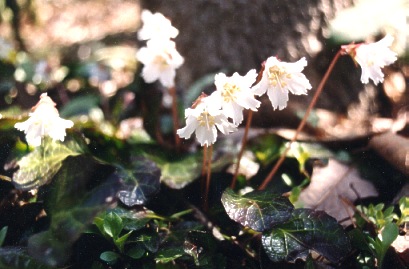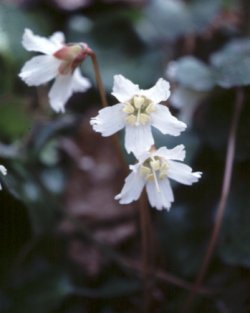Shortia galacifolia (Oconee bell)

It's been a while since Jurisdynamics last featured a taxon of the week. There's no land as dear as what we knew in our formative years (early adolescence and a few years on either side of it). On the assumption that can always go home again if you really want, I'll reach back to a signature plant of Georgia and its neighboring states.
 The southern Appalachians aren't quite Hawaii or the California floristic province, but they host their share of biological diversity. Shortia galacifolia, known commonly as the Oconee bell, is one of the rarest wildflowers in the United States. It is found in only seven counties in Georgia and the Carolinas. Oconee bells favor shady woods and stream banks. They are most abundant in rich soils in the cool, humid environment of river ravines.
The southern Appalachians aren't quite Hawaii or the California floristic province, but they host their share of biological diversity. Shortia galacifolia, known commonly as the Oconee bell, is one of the rarest wildflowers in the United States. It is found in only seven counties in Georgia and the Carolinas. Oconee bells favor shady woods and stream banks. They are most abundant in rich soils in the cool, humid environment of river ravines.As with many other taxa in the southern Appalachians (or anywhere else, really), Oconee bells are most threatened by habitat destruction. According to one account, the plant disappeared from sight for nearly a century after the Frenchman Andre Michaux identified S. galacifolia in 1788. Botanists no less renowned than Asa Gray (known for his correspondence with and influence on Darwin) and John Torrey searched in vain for another specimen of Michaux's plant. "[T]he elusive plant, like the Holy Grail, began to take on mythical proportions. Finally, after nearly 100 years, a 17-year old boy named George Hyams rediscovered the plant in 1877 in McDowell County, N.C."
 None of this stopped South Carolina and the Duke Power Company from flooding 4,500 acres in the area in 1973. One can only hope that Lake Jocassee is worth the human and natural history buried beneath this reservoir. In addition to drowning an untold number of endemic plants, the Jocassee project occasioned the removal of a church that figured in the filming of Deliverance.
None of this stopped South Carolina and the Duke Power Company from flooding 4,500 acres in the area in 1973. One can only hope that Lake Jocassee is worth the human and natural history buried beneath this reservoir. In addition to drowning an untold number of endemic plants, the Jocassee project occasioned the removal of a church that figured in the filming of Deliverance.Fortunately, Oconee bells fare quite nicely when transplanted. The wild provenance of the Rabun County population, the only one found in Georgia, is fiercely disputed; detractors argue that the Rabun colony of Oconee bells is comprised of deliberate transplants. As Shortia, Oconee bells now appear on Wikipedia's list of garden plants. Domestication is hardly an option for most plants with such a restricted range, and garden-variety Oconee bells are no substitute for their wild cousins.
 Oconee bells retain enormous cultural value. Under the name "Acony Bell,"
Oconee bells retain enormous cultural value. Under the name "Acony Bell," The fairest bloom the mountain knowsAnd of course, it is impossible to speak of Gillian Welch or Revival without mentioning "Annabelle,"
Is not an iris or a wild rose
But the little flower of which I'll tell
Known as the brave acony bell
Just a simple flower so small and plain
With a pearly hue and a little known name
But the yellow birds sing when they see it bloom
For they know that spring is coming soon
Well it makes its home mid the rocks and the rills
Where the snow lies deep on the windy hills
And it tells the world "why should I wait
This ice and snow is gonna melt away"
And so I'll sing that yellow bird's song
For the troubled times will soon be gone
We lease twenty acres and one Ginny mule
From the Alabama trust
For half of the cotton and a third of the corn
We get a handful of dust
We cannot have all things to please us
No matter how we try
Until we've all gone to Jesus
We can only wonder why
I had a daughter called her Annabelle
She's the apple of my eye
Tried to give her something like I never had
Didn't ever want to ever hear her cry
We cannot have all things to please us
No matter how we try
Until we've all gone to Jesus
We can only wonder why
When I'm dead and buried
I'll take a hard life of tears
From every day I've ever known
Anna's in the churchyard she got no life at all
She only got these words on a stone
We cannot have all things to please us
No matter how we try
Until we've all gone to Jesus
We can only wonder why

Update (October 30, 2006): I hasten to add this spectacular image of an Oconee bell bud, taken by Rich Stevenson on March 19, 2005, and posted at pbase.com:













0 Comments:
Post a Comment
<< Home